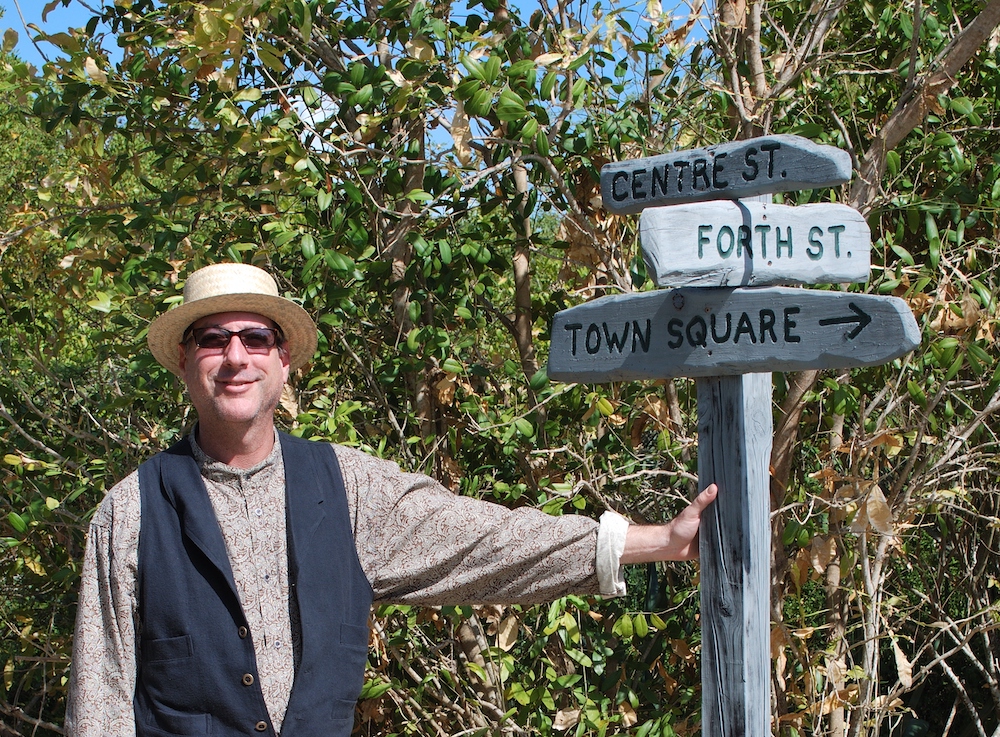As curator and historian at Islamorada’s Keys History & Discovery Center, Brad Bertelli is a storyteller who spins colorful, articulate tales with rich factual details about life in the Florida Keys.

Brad and his wife Michelle, seen here at the opening of the Discovery Center’s Indian Key exhibit, have been married for 11 years.
He’s also the author of several books — two about snorkeling in Florida and the Keys, and two separate titles about Key Largo and Islamorada — and he co-wrote “A Local’s Guide to Bloodline: 50 Famous Film Locations in the Florida Keys.”
Currently Brad is penning a book of Florida Keys stories. He admits to writing six or seven days a week and credits his wife with being “very forgiving” of his creative habits.
He first spotted his wife of 11 years, Michelle, when she pulled into the parking lot of the Islamorada restaurant where he was working. She applied for a job and, at Brad’s urging, the manager hired her.
A love of islands lured Brad to the Keys from Huntington Beach, California, though he took a circuitous route that included a detour to Captiva Island, where he stayed for several years.
Later Brad earned a full scholarship at University of Miami. He then moved to the Keys, working for 10 years as a waiter at Lazy Days and teaching part-time at the local community college.
The Plantation Key resident is also a member of Islamorada’s Village of Islands Historic Preservation Commission.
“Everything I do is history. I know a lot, but the more I learn, the less I know,” Brad said.
Keys Voices: When did you first come to the Florida Keys and why?
Brad Bertelli: I moved to Plantation Key in 2001. I had just graduated from University of Miami with an MFA degree in creative writing and wanted to finish my great Florida novel. The road has forked a bit, but one day I’ll get back to it.

Brad (at right) shows elements of the Indian Key exhibit to park ranger Mike Guarino following the exhibit’s unveiling.
KV: What aspects of the Keys environment or way of life matter most to you?
BB: I like the warmth, the small-town feel and the rum-friendly vibe.
KV: Who or what inspired you to become passionate about respecting and protecting the Keys’ natural world?
BB: I was working on a snorkeling book and every captain had a different story about the “history” of whatever reef we were exploring. The more I learned about the incredible breadth of local history, the less I wrote fiction and the more I began writing about the Keys.
KV: How does that passion influence your work or profession?
BB: At heart I am a storyteller. Working as the curator at Islamorada’s Keys History & Discovery Center has afforded me the opportunity to share some of these great histories on a spectacular scale. I have been able to write what is basically an interactive book with images, artifacts and exhibits at the museum for both our community members and visitors to experience.
KV: What are some of the ways, personally or through your work, that you connect with and/or help protect the local environment and unique lifestyle?
BB: Beyond the stories I’ve been able to tell at the Discovery Center, I have several books about the Keys that explore the amazing history, including how that history has affected the fragile ecosystems. For years I’ve written columns about Keys history in local newspapers. Also, I’ve been fortunate enough to be invited by community groups from Ocean Reef to Key West to talk and share my knowledge.

The center’s First People exhibition explores the indigenous people of the Florida Keys, who inhabited the area more than 1,000 years ago.
KV: What keeps you energized, challenged and focused on your path?
BB: I’m always learning. The Keys stretch out over 100 miles, but they are connected. It’s not by roads and bridges, but by shared events and family histories. The more I continue to learn, the more connections I come to understand and that helps me tell better stories. My desire to tell increasingly better stories about the Florida Keys keeps me learning.
KV: What do you hope your positive environmental actions will accomplish?
BB: I just want to keep doing my job at the Keys History & Discovery Center, developing exhibits that showcase the amazing history of the Florida Keys and, through them, enable people to hopefully experience a little deeper understanding of the island chain and the fragile environment we all share.
KV: What’s your favorite natural or eco-friendly activity in the Keys?
BB: Getting on a kayak and paddling out to Indian Key Historic State Park. Getting out there and around the island chain’s only ghost town never ceases to amaze me.

